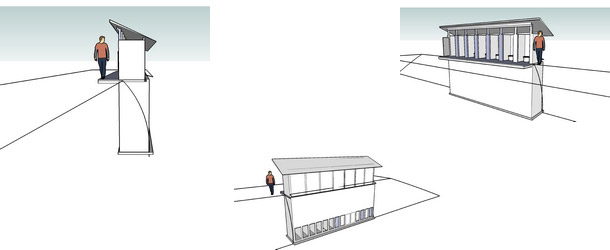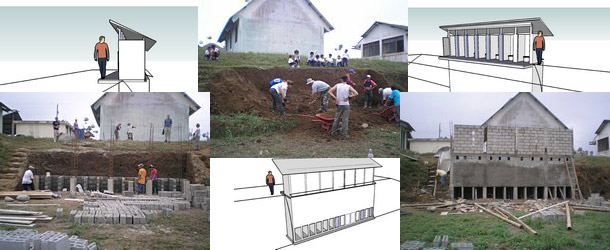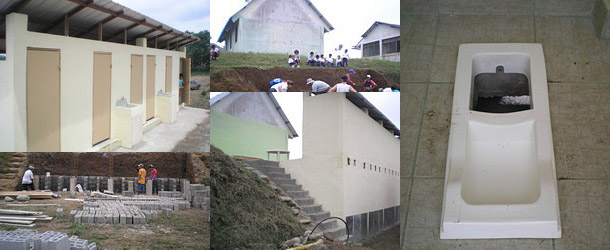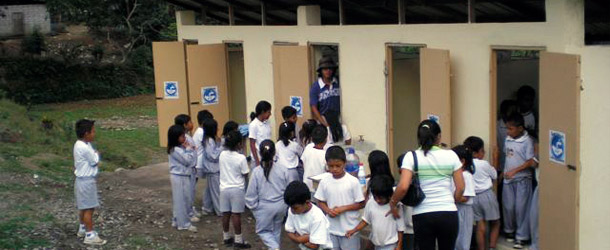Ecological Sanitation
Ecological Sanitation for Abraham Calazacon School in Bua
In September 2009 Yanapuma started work on a project to construct ecological dry toilets for the 250 children and staff of the Abraham Calazacon school in Bua. This work was made possible with the support of the Portland, Oregon branch of Engineers Without Borders, and Thinking Beyond Borders, who joined us with 16 students to work on the project during September and October.
Read about our pilot ecosanitation project here!
The project was virtually completed on 31st of October when a meeting of the local government took place in the school and we were able to demonstrate to various provincial governmnent authorities the advantages of ecological dry toilets. The project has created a great deal of interest and has led to invitations to present more information to various offices. We have also been invited by the Patronato Provincial to undertake similar projects in 4 or 5 surrounding schools.
The construction consists of a block of 6 toilets that work by separating the urine from the solids. The urine is stored for up to 20 days before being fed through tubes across the playing field where it will be used to fertilize fruit trees planted by the children of the school. The solid material is covered with lime, crumbled dry leaves, etc, which causes it to begin to dessicate quickly. This removes any smell and makes it a hostile environment for insects. Each toilet has two chambers; one which is in use and the other which is left to rest after it has been filled up to the maximum level. During the resting period the pathogen count steadily drops due to the alkilinity and dryness of the environment.
Tests carried out on the dry toilet project in 2010 showed that after 6 months the coliform count had dropped to about 42 parts per gram, with under one hundred being considered safe for use on fruiting trees and bushes. We are continuing to store the material for a longer period to monitor further reduction and are looking at feasible options for reducing the count to 0, at which point it would be safe for use on vegetable crops.
In order to make the system as maintenance-free as possible we installed a 2500 litre tank for the urine and set up a system for the urine to enter the tank at the bottom with baffles to present mixing. As more urine enters, the older urine rises nearer the top until it finally flows out into the pipe that will carry it across the playing field. The process of storing the urine is recommended by the WHO and leads to it becoming a more potent fertilizer that will not burn the roots of the plants.
We took advantage of a difference in levels between the school and the playing fields to construct the toilet block so that the chambers are up to 3.5 meters deep. This will give us sufficient volume to be able to store the dried material for about a year, which will significantly reduce the danger of pathogens being able to survive. Actually, the biggest problem will be dealing with the large quantities of urine - 150 - 250 liters or more per day is what we are planning for.
As with our previous ecological toilet project there will be a substantial educational component and we will put as much time as is necessary into educating the children how to use and maintain them and about the environmental advantages of the system.
Work started by clearing the site, digging out some of the hillside with the fathers of some of the children. Then, with a local builder and two assistants we began to construct the foundation and the chambers for 6 toilets. Meanwhile, student volunteers began to dig the trenches to transport the aged urine to the far side of the playing field where it will filter through perforated drainage pipes and gravel into the soil to feed the fruit trees.
After five weeks of construction the toilet block had a roof, doors and the first of the new fiberglass inserts that we designed. The school's director surveyed the children beforehand to find out what they use at home. The result showed that the vast majority of the children use at best a squatting system over a pit latrine, or in some cases just anywhere in the woods. Thus we designed the separator insert as a squat system, which is also a healthier way for the human body. Questions we are going to have to monitor include just how these function in practice, especially in relation to cleaning them regularly.
You can read about Bua here.




